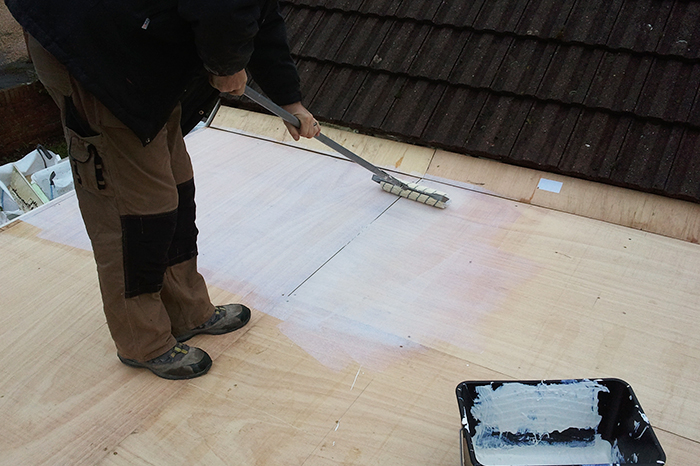What are the Adhesives and Primers used in EPDM Roofing?

Here at Rubber Flat Roof, we have tried many a rubber flat roof adhesive over the years, from the older styles of adhesives to the newer, cutting-edge EPDM technologies.
In this article, we will review the main types of adhesives and primers to consider when you've started the EPDM bonding process.
1. Water-based adhesives
Key advantages: slow drying process, easy application, strong bond with sturdy wood surfaces, long-lasting bond results.
A water-based adhesive is ideal for adhering EPDM onto flat or relatively low-slope roofs. It is also best when attaching EPDM membranes to a strong, rigid surface such as plywood and wood fibreboard. water-based and solvent-based flat roof adhesives, these offer a particular advantage. When bonding to plywood and various wood fibreboards, the adhesive only needs to be applied to one surface, and the EPDM membrane can be placed in position before the adhesive has dried. This allows you to reposition the membrane if necessary to reduce wrinkles. In order to get the best result from this kind of flat roof adhesive, make sure the areas being bonded are clean and free from any grease or dirt before you start. Also, when bonding, use a roller or a brush to apply the water-based adhesives evenly.
2. Solvent/ Contact Adhesives
Key advantages: fast curing, suited to sealing EPDM on complicated roof structures; easy application.
One of the second most common flat roof adhesives is a solvent/contact adhesive. These offer an instant bond, unlike the water-based adhesives, and work best with rubber, metal, timber and cement surfaces. They need to be applied to both surfaces. Look for a solvent resistant roller and/or brush to properly apply the adhesive. Solvent-based adhesives work perfectly for roofs with angle changes or unique features. Remember that the solvent in the adhesive is a strong chemical so be careful when using it. Keep your work area well ventilated and have regular breaks if needed. Avoid contact with your eyes or skin by wearing safety goggles and chemical resistant gloves.
3. Primers
Key advantages: fast curing time, creates a stronger rubber-to-rubber bond, when used correctly, it prepares the membrane and substrate.
Primers are used to bond tapes and accessories to an EPDM rubber membrane. They are also used to clean and prepare rubber surfaces before using other various tapes. If it is not used, the surfaces will not be properly bonded together and your flat roof adhesive will have a shorter lifespan. You will also need to use a scrub pad on the EPDM membrane. This will scarf the rubber so that the two surfaces (rubber-to-rubber or seam tape) will adhere together to create a strong bond. When applying the primer, ensure that you apply it evenly to avoid pooling, and only bond the surfaces when the primer is dry to the touch. If you’re unsure, have a look at our EPDM installation guide.
4. MS Polymers
Key advantages: versatile sealant for a variety of surfaces and areas, can be repainted for colour preferences, extremely strong.
MS (mighty strength) Polymer flat roof adhesives are available in different colours and are of trade strength. They are often described as hybrid sealants, as they are long lasting and flexible adhesives that will stick to non-porous surfaces and even damp surfaces. The mighty strength of the product means that it comes in a small tube. This makes it great for sealing and waterproofing small areas like joints. This kind of adhesive can also be painted over with the majority of paints, so it is a good all-round flat roof adhesive.
5. Lap Caulk
Key advantages: functions with a range of surfaces, weather resistant, easy application for difficult areas.
Lap Caulk is a solvent-based sealant. It prevents water from wicking into the scrim and destroying the membrane. It can be used with metal, wood, concrete, glass and rubber surfaces and is very weather resistant. It provides an effective seal for particularly cold climates. Lap Caulk is applied using a sealant gun to small and sometimes difficult to reach areas, such as exposed edges of rubber seams and uncured rubber flashings. If you want to clean the surrounding area after application, try using Toluene or Xylene.
6. Water Cut-Off Mastic
Key advantages: clear, easy to use in hard to reach areas, an emergency waterproofing solution.
Water cut-off mastic is clear mastic that is applied with a mastic gun. It is a compression-based adhesive, which means it is not suitable as a sealant for wall chases or gaps. Water cut-off mastic should be used where the flat roof membrane has been mechanically terminated and applied between the substrate and the membrane, before installing termination bars and pipe boot clamps. It can also be used in emergencies as an overnight water-stop or temporary sealant.
For more advice on your EPDM rubber roofing project, get in touch today: phone us on 01392 927729 or email sales@rubberflatroof.co.uk.
















